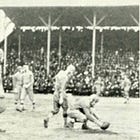Today's Tidbit... Holders And Other Put Downs
Some time back, a reader, Ed Jarvis, asked about a 1940 program cover showing a holder on a kickoff, and wondered why the team used a holder rather than a tee? Ed might have seen one of covers below or a different cover, but his question remains: "What was the deal with holders back then?"
If you want the full story, I covered the question in the July 2022 Tidbit below.
The shorthand answer is that football originally did not allow artificial tees, so kickers had three options: 1) have a teammate hold the ball, 2) make a divot in the ground with their heel and place the ball in the divot, or 3) gather dirt to build a mound on which they placed the ball. (Golfers also built dirt or sand mounds early on.) However, some kickers got clever and had tees made of baked clay, figuring that since clay is a natural substance, not artificial, they could get away with their little caper.
Of course, kickers seldom brought enough tees to share with everyone, so the rules committee banned all tees in 1922 and kept them off the field until 1944 when they reversed their ruling. So, the answer to Ed's question is that kickers in 1940 often had teammates hold the ball on kickoffs because tees were banned at the time.
While some in the football community disrespect kickers, few roles earn less consideration, if not respect, than holders, who weren't even called holders early on.
When researching the recent series on the 1883 Michigan team and their four-game road trip to the East Coast, I found a report on the trip in the Michigan Argonaut. While reflecting on the trip, the reporter launched into a long complaint about the officiating, a part of which concerned the referee's ruling about Michigan's holder on kickoffs.
I looked around and could not find anyone else using "putter-down" to describe the holder, so it appears to have been a Michigan-specific term. The term typically used back then to describe the person who placed the ball on the ground for the kicker was the "placer." Placer was the term used in the rule book, such as 1892 rule 33b, which covered the issue Michigan complained about in 1883:
The placer in a try-at-goal may be off side or out of bounds without vitiating the kick.
By 1898, the terminology switched, so the person became a holder rather than a placer.
The holder of the ball in any place kick may be off side or out of bounds without vitiating the kick.
The terminology switch seems a bit odd since "holder' was already used in many rules to describe the "holder of the ball," aka the ball carrier, and holding had another meaning that resulted in a major penalty. You might think that placer would have stuck around a bit longer, but it didn't, and we've called them holders ever since.
Of course, if you are dying to read more about kickers and their contributions to the game, the stories below should make you happy.
Click here for options on how to support this site beyond a free subscription.









"...without vitiating the kick." Vitiating--great word! I can just hear Sean Hochuli proclaiming, "The kick is vitiated."